5.4E: Exercises
- Page ID
- 31119
5.4: Right Triangle Trigonometry
Verbal
1) For the given right triangle, label the adjacent side, opposite side, and hypotenuse for the indicated angle.
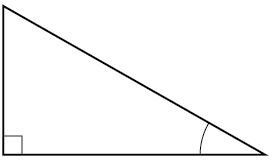
- Answer
-
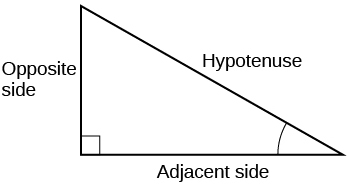
2) When a right triangle with a hypotenuse of \(1\) is placed in the unit circle, which sides of the triangle correspond to the \(x\)- and \(y\)-coordinates?
3) The tangent of an angle compares which sides of the right triangle?
- Answer
-
The tangent of an angle is the ratio of the opposite side to the adjacent side.
4) What is the relationship between the two acute angles in a right triangle?
5) Explain the cofunction identity.
- Answer
-
For example, the sine of an angle is equal to the cosine of its complement; the cosine of an angle is equal to the sine of its complement.
Algebraic
For the exercises 6-9, use cofunctions of complementary angles.
6) \( \cos (34°)= \sin (\_\_°)\)
7) \( \cos (\dfrac{π}{3})= \sin (\_\_\_) \)
- Answer
-
\(\dfrac{π}{6}\)
8) \( \csc (21°) = \sec (\_\_\_°)\)
9) \( \tan (\dfrac{π}{4})= \cot (\_\_)\)
- Answer
-
\(\dfrac{π}{4}\)
For the exercises 10-16, find the lengths of the missing sides if side \(a\) is opposite angle \(A\), side \(b\) is opposite angle \(B\), and side \(c\) is the hypotenuse.
10) \( \cos B= \dfrac{4}{5},a=10\)
11) \( \sin B= \dfrac{1}{2}, a=20\)
- Answer
-
\(b= \dfrac{20\sqrt{3}}{3},c= \dfrac{40\sqrt{3}}{3}\)
12) \( \tan A= \dfrac{5}{12},b=6\)
13) \( \tan A=100,b=100\)
- Answer
-
\(a=10,000,c=10,000.5\)
14) \(\sin B=\dfrac{1}{\sqrt{3}}, a=2 \)
15) \(a=5, ∡ A=60^∘\)
- Answer
-
\(b=\dfrac{5\sqrt{3}}{3},c=\dfrac{10\sqrt{3}}{3}\)
16) \(c=12, ∡ A=45^∘\)
Graphical
For the exercises 17-22, use Figure below to evaluate each trigonometric function of angle \(A\).
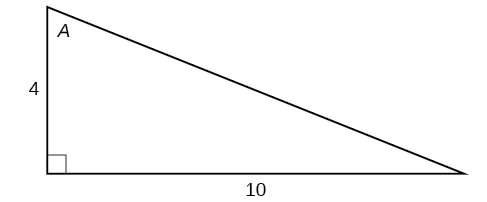
17) \(\sin A\)
- Answer
-
\(\dfrac{5\sqrt{29}}{29}\)
18) \( \cos A \)
19) \( \tan A \)
- Answer
-
\(\dfrac{5}{2}\)
20) \(\csc A \)
21) \( \sec A \)
- Answer
-
\(\dfrac{\sqrt{29}}{2}\)
22) \( \cot A \)
For the exercises 23-,28 use Figure below to evaluate each trigonometric function of angle \(A\).
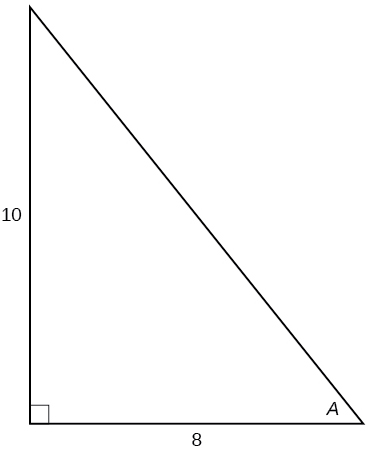
23) \( \sin A\)
- Answer
-
\(\dfrac{5\sqrt{41}}{41}\)
24) \( \cos A\)
25) \( \tan A \)
- Answer
-
\(\dfrac{5}{4}\)
26) \( \csc A\)
27) \( \sec A\)
- Answer
-
\(\dfrac{\sqrt{41}}{4}\)
28) \(\cot A\)
For the exercises 29-31, solve for the unknown sides of the given triangle.
29)
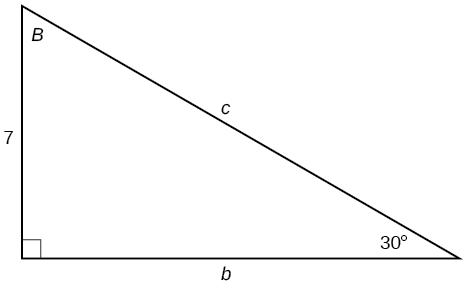
- Answer
-
\(c=14, b=7\sqrt{3}\)
30)
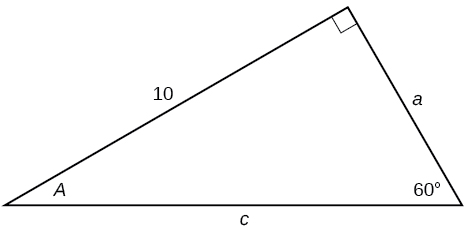
31)
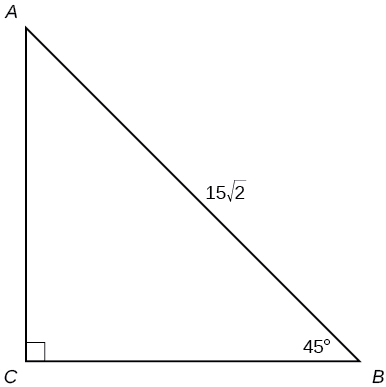
- Answer
-
\(a=15, b=15 \)
Technology
For the exercises 32-41, use a calculator to find the length of each side to four decimal places.
32)
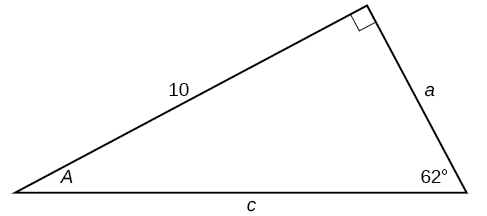
33)
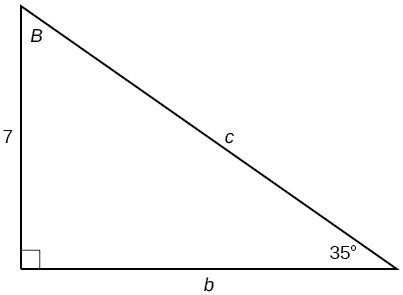
- Answer
-
\(b=9.9970, c=12.2041\)
34)
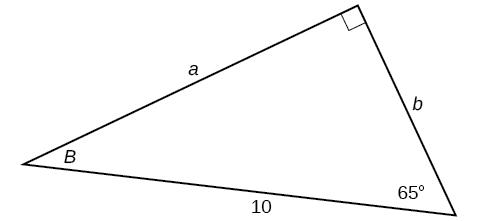
35)

- Answer
-
\(a=2.0838, b=11.8177\)
36)

37) \(b=15, ∡B=15^∘\)
- Answer
-
\(a=55.9808,c=57.9555\)
38) \(c=200, ∡B=5^∘\)
39) \(c=50, ∡B=21^∘\)
- Answer
-
\(a=46.6790,b=17.9184\)
40) \(a=30, ∡A=27^∘\)
41) \(b=3.5, ∡A=78^∘\)
- Answer
-
\(a=16.4662,c=16.8341\)
Extensions
42) Find \(x\).
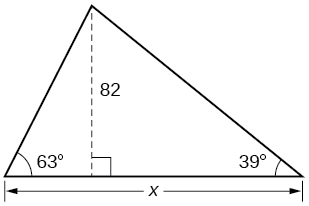
43) Find \(x\).
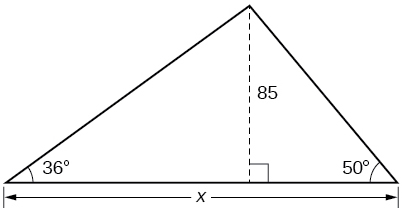
- Answer
-
\(188.3159\)
44) Find \(x\).
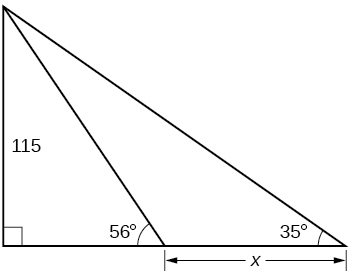
45) Find \(x\).
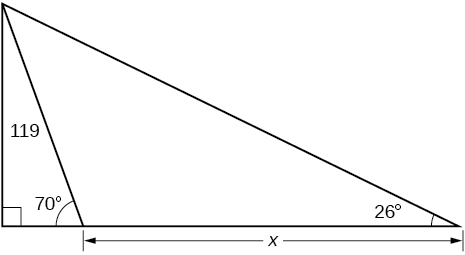
- Answer
-
\(200.6737\)
46) A radio tower is located \(400\) feet from a building. From a window in the building, a person determines that the angle of elevation to the top of the tower is \(36°\), and that the angle of depression to the bottom of the tower is \(23°\). How tall is the tower?
47) A radio tower is located \(325\) feet from a building. From a window in the building, a person determines that the angle of elevation to the top of the tower is \(43°\), and that the angle of depression to the bottom of the tower is \(31°\). How tall is the tower?
- Answer
-
\(498.3471\) ft
48) A \(200\)-foot tall monument is located in the distance. From a window in a building, a person determines that the angle of elevation to the top of the monument is \(15°\), and that the angle of depression to the bottom of the tower is \(2°\). How far is the person from the monument?
49) A \(400\)-foot tall monument is located in the distance. From a window in a building, a person determines that the angle of elevation to the top of the monument is \(18°\), and that the angle of depression to the bottom of the monument is \(3°\). How far is the person from the monument?
- Answer
-
\(1060.09\) ft
50) There is an antenna on the top of a building. From a location \(300\) feet from the base of the building, the angle of elevation to the top of the building is measured to be \(40°\). From the same location, the angle of elevation to the top of the antenna is measured to be \(43°\). Find the height of the antenna.
51) There is lightning rod on the top of a building. From a location \(500\) feet from the base of the building, the angle of elevation to the top of the building is measured to be \(36°\). From the same location, the angle of elevation to the top of the lightning rod is measured to be \(38°\). Find the height of the lightning rod.
- Answer
-
\(27.372\) ft
Real-World Applications
52) A \(33\)-ft ladder leans against a building so that the angle between the ground and the ladder is \(80°\). How high does the ladder reach up the side of the building?
53) A \(23\)-ft ladder leans against a building so that the angle between the ground and the ladder is \(80°\). How high does the ladder reach up the side of the building?
- Answer
-
\(22.6506\) ft
54) The angle of elevation to the top of a building in New York is found to be \(9\) degrees from the ground at a distance of \(1\) mile from the base of the building. Using this information, find the height of the building.
55) The angle of elevation to the top of a building in Seattle is found to be \(2\) degrees from the ground at a distance of \(2\) miles from the base of the building. Using this information, find the height of the building.
- Answer
-
\(368.7633\) ft
56) Assuming that a \(370\)-foot tall giant redwood grows vertically, if I walk a certain distance from the tree and measure the angle of elevation to the top of the tree to be \(60°\), how far from the base of the tree am I?
Contributor
Jay Abramson (Arizona State University) with contributing authors. Textbook content produced by OpenStax College is licensed under a Creative Commons Attribution License 4.0 license. Download for free at https://openstax.org/details/books/precalculus.


